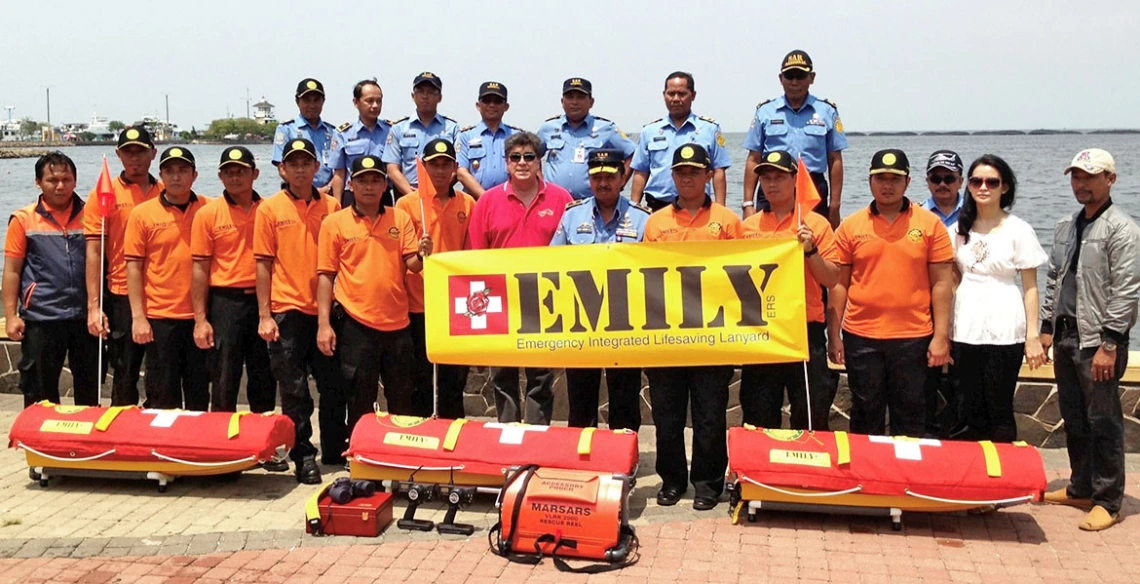15 years of lifesaving entrepreneurship
Alum’s robotic inventions give emergency responders a major edge in water rescue.

Anthony Mulligan (front row, center) trains members of the Indonesian National Ministry of Search and Rescue to use the EMILY (Emergency Integrated Lifesaving Lanyard) rescue craft in Jakarta.
In 2009, Anthony Mulligan had just sold his successful aerial drone company to British defense behemoth BAE Systems and was considering ideas on what to do next.
“I wanted to stay in the unmanned robotics industry, but couldn’t make flying vehicles at that point, so I decided to make a robot boat,” the mechanical engineering alum said. “I was living in Malibu, so it was very convenient.”
Mulligan started developing a robotic craft to research marine wildlife with the National Oceanic and Atmospheric Administration. But, as he and his partner Robert Lautrup looked out at the nearby Pacific beaches, they realized the design could be transformed into a remotely controlled rescue vehicle to assist lifeguards and first responders in saving lives.
“We started building durable little boats that could operate in any weather conditions and carry a life jacket,” he said. “We talked with the lifeguards, and they really liked the idea, so we built a prototype. The first time we saw it go through the waves in the surf – with no problem at all – we knew it would have an impact.”
Fast forward 15 years, and Mulligan’s invention, EMILY (Emergency Integrated Lifesaving Lanyard) rescue craft are in use at beachfronts and resorts all over the world. Mulligan’s company, Hydronalix, has sold more than 2,000 of the aquatic rescue boats. First responders keep the EMILY craft right on the beach. In Los Angeles alone, EMILY can be deployed in up to 400 rescue events during a typical three-day holiday weekend.
Local resources, global enterprise
Hydronalix is based in Sahuarita, Arizona, where Mulligan employs 50 workers in the research and production of robotic vehicles, a roster which now includes an expanded array of watercraft and aerial drones. Construction is demanding, as almost none of the parts are available off the shelf.
“There weren’t any commercially available components you could buy and put in,” the 1988 graduate explained. “Nobody builds pumps that are that efficient in that size, or motor controllers that can handle that current. We had to develop our own manufacturing line, right down to the circuit boards.”
The demands of custom construction compelled Mulligan to situate his company in Sahuarita, which boasts a pool of intellectual capital and skilled workers.
“The College of Engineering at the University of Arizona has been very beneficial for us. We can hire people who can solve problems,” said Mulligan, who won the college’s Leo B. Hart Humanitarian Award in 2016. “That, combined with the low cost of being in Southern Arizona, is a key part of being competitive globally.”
Hydronalix has sponsored several capstone projects as part of the Craig M. Berge Design Program and engages about 10 interns annually, many from the university. The students typically work during the summer, but some stay as long as a year. The interns get hands-on experience in the research, design, and manufacturing process, and those interested in field work can join operations teams doing testing and training.
Inventions for any mission
Hydronalix recently invented and released a new, larger rescue craft that is unlike any other on the market. The CASVAC (Casualty Evacuation Unmanned Surface Vehicle) is a covered rescue craft that can operate autonomously or be controlled remotely to reach an injured victim and transport them back to safety. If needed, the craft can carry a first responder or EMT. The CASVAC, which weighs 200 lbs. and folds up compactly for easy transport, is intended to aid in hard-to-reach aquatic rescues where medical attention is needed – for instance during a flood, or if a shoreline emergency is inaccessible due to fire or another hazard.
The company’s new aerial drone, the Hermes-1, is specially designed for flood rescues. Remote operators can use the drone, which has probes mounted on the bottom, to determine water depths in flooded areas to check conditions. They can assess
whether it is safe to drive a vehicle through a flooded area for rescue support, for example, by checking water depth with a mobile phone using an app.
Hydronalix also builds tactical sonar boats and unmanned surface vehicles, and Mulligan recently won a $42 million, five-year contract for his company from the U.S. Navy to develop advanced technology for unmanned watercraft.
“We do a lot of work for the Navy and Marines for humanitarian missions,” said Mulligan. “This will allow us to keep making better and better boats, and lots of them.”

